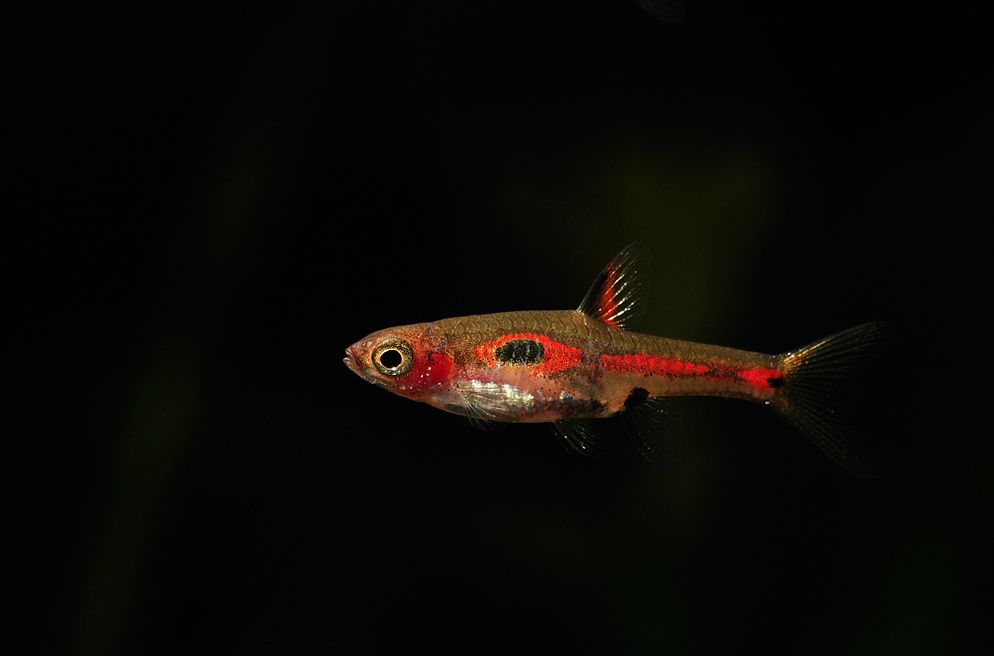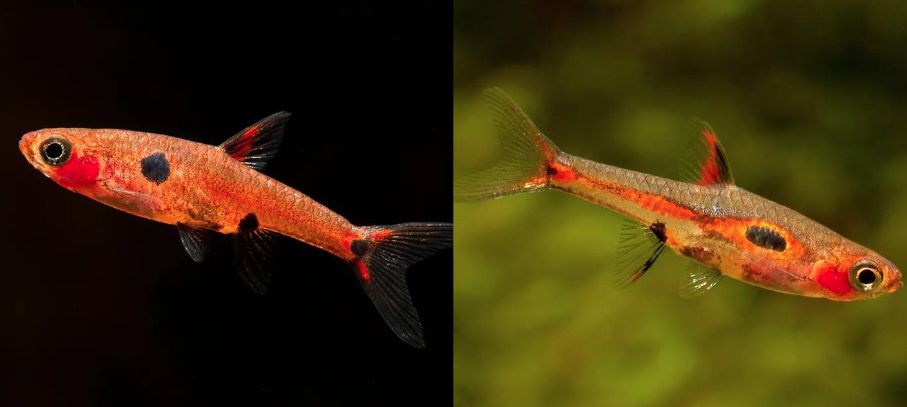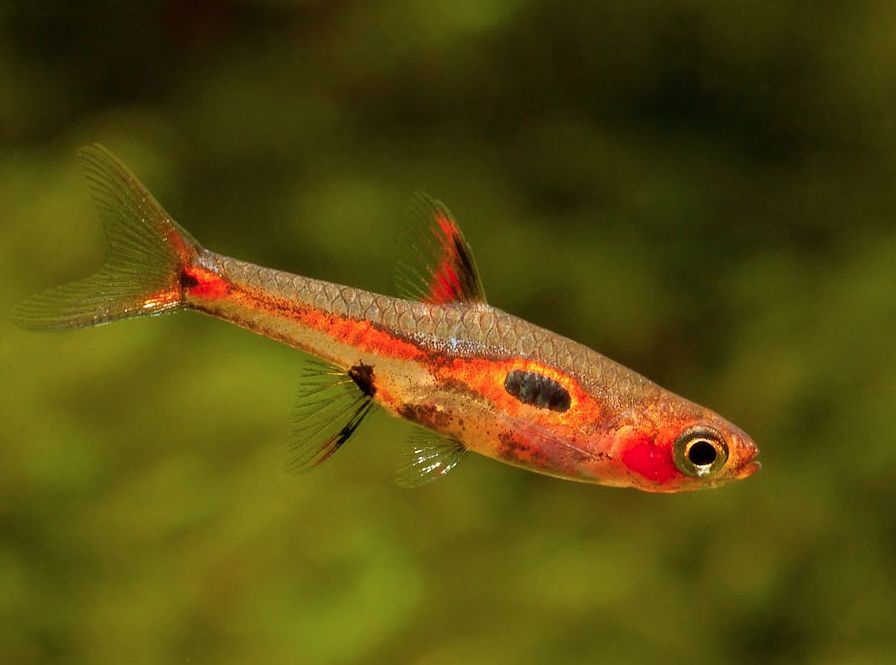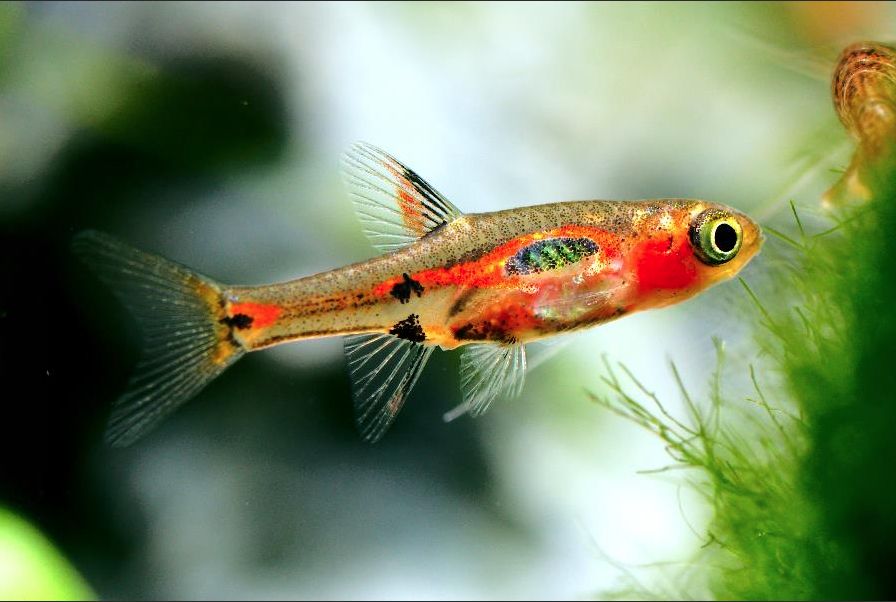The phoenix rasbora is a striking nano fish belonging to the Boraras genus, making it a favorite among aquarists. Known for its vibrant colors and distinctive appearance, this small fish is not only aesthetically pleasing but also exhibits captivating schooling behavior and a peaceful temperament. With its diminutive size, the phoenix rasbora is ideal for nano tanks, where it thrives in a community setting.
One of the remarkable qualities of this species is its compatibility with various tank inhabitants, including all types of dwarf shrimp, making it a safe choice for community aquariums. Keeping a group of phoenix rasboras enhances their natural schooling behavior, which adds dynamic movement and color to your aquarium.

Contents
Habitat in the wild
The phoenix rasbora is endemic to Borneo, with populations notably captured in the River Jelai Bila basin, located near the city of Sintang in the Indonesian province of Kalimantan. Its natural habitat extends westward from the Jelai Bila interstream area, while the related species, B. brigittae, is typically found to the east.
This small fish inhabits black waters and rivers associated with forest peat bogs. The water in these regions appears brown due to tannins and other organic compounds released from decomposing materials, including fallen leaves, branches, and wood.
The water in these biotopes is generally soft and acidic, often with a pH as low as 4.0, and experiences limited light penetration due to the dense forest canopy above. The phoenix rasbora is known for its striking coloration, which becomes more vibrant when kept in conditions that mimic its natural habitat. These fish are social creatures and are most comfortable when kept in groups of at least six, which helps replicate their natural schooling behavior and reduces stress.
Unfortunately, these critical habitats are severely threatened across Southeast Asia due to the expansion of natural rubber and oil palm plantations, urban development, and other human activities. The loss of these ecosystems not only impacts the phoenix rasbora but also endangers a variety of species that rely on these unique environments. Peat swamp forests, where the phoenix rasbora is found, play a vital role in carbon storage, making their conservation important for climate regulation. Additionally, these forests are among the most biodiverse ecosystems, housing numerous species of flora and fauna that are not found elsewhere. Conservation efforts in Borneo aim to protect these delicate ecosystems from further degradation, highlighting the need for sustainable practices in agriculture and development.
Description
The body length of the phoenix rasbora ranges from 15 to 20 mm. Its specific name consists of two parts: “Boraras,” which is derived from an anagram of the generic name “Rasbora,” and “mera,” which comes from the Indonesian word “mera,” meaning “red,” referring to the fish’s predominant coloration.
Proper identification of the phoenix rasbora is essential, as it is often confused with other species of the Rasbora family. In particular, it bears similarities to Boraras brigittae and Boraras maculatus. However, the phoenix rasbora can be distinguished by its less homogenous red coloring and the presence of a broken horizontal black stripe, which sets it apart from Boraras brigittae.
Aquarists should take care to accurately identify this fish before purchasing it from a local pet shop, as ensuring the right species is crucial for maintaining a healthy aquarium environment. The phoenix rasbora’s coloration can intensify based on water quality and conditions, showcasing a vivid display of red that captivates aquarists. Additionally, these fish are typically more active during dawn and dusk, displaying their schooling behavior, which can be an enchanting sight in a well-planted aquarium.
| Characteristic | Description |
|---|---|
| Scientific Name | Boraras merah |
| Common Name | Phoenix Rasbora |
| Origin | Southeast Asia (Indonesia, Malaysia) |
| Size | Up to 1 inch (2.5 cm) |
| Lifespan | 2-3 years |
| Temperature Range | 75°F to 82°F (24°C to 28°C) |
| pH Range | 6.0 to 7.5 |
| Water Hardness | Soft to slightly hard (5-12 dGH) |
| Tank Size | Minimum 10 gallons (38 liters) |
| Behavior | Peaceful, shoaling fish |
| Diet | Omnivorous, small live and frozen foods |
| Tank Level | Middle to top |
| Compatibility | Suitable for peaceful community tanks |
| Breeding | Egg-scatterer, moderately difficult to breed |
| Special Considerations | Prefers dimly lit, well-planted aquariums |

Difficulties in keeping
The phoenix rasbora is highly regarded among aquarists due to its vibrant coloration and active, peaceful temperament. In an aquarium setting, this fish demonstrates resilience and adaptability, thriving within a broad range of water parameters. However, its colors are most striking when kept in warm, soft water and in groups of at least 10 individuals.
Given its small adult size, it is advisable to avoid larger or fast-swimming tank mates, as they may intimidate or outcompete the phoenix rasbora.

Keeping in a tank
Lifespan
Provided with good care, its average lifespan varies from 3 to 5 years.
Tank capacity
Despite its small size, the phoenix rasbora requires adequate swimming space. During the spawning period, dominant males establish and defend territories, making it essential to house them in a tank with a minimum bottom size of 45 x 30 cm to accommodate their behavior.
Phoenix rasboras primarily inhabit the upper and middle water layers of the aquarium, but they can often be seen swimming and foraging in the lower layers as well. Providing a well-structured environment with plants and decorations can help create visual barriers, allowing the fish to establish their territories while still promoting a natural swimming space.
Water parameters
Optimal water parameters for the phoenix rasbora are as follows:
- Temperature: 75°F to 82°F (24°C to 28°C)
- pH Level: 6.0 to 7.5
- Water Hardness: Soft to slightly hard (5-12 dGH)
Maintaining stability in these water parameters is crucial, as sudden fluctuations can stress the fish, making them more susceptible to diseases. Regular water testing and maintenance are essential to ensure a stable and healthy environment for your phoenix rasboras.
Plants, substrate, and decorations
This dwarf rasbora, typically found in bogs and streams with black water, exhibits its most vibrant colors and natural behaviors in conditions that closely resemble its native habitat. To enhance its appearance, consider adding oak leaves or similar plant materials to the tank. These leaves can release tannins into the water, which can help soften it and create a more suitable environment for the fish.
Incorporating driftwood, roots, or tree branches to diffuse the light entering the aquarium is highly beneficial, as it creates a more natural environment. A soft sand substrate is the ideal choice, as it mimics the fish’s natural habitat. Adding roots and snags can create shaded areas, providing additional hiding spots and reducing stress for the fish. If you cannot find a snag of the appropriate shape, using well-dried beech or oak wood—after removing the bark—can serve as a suitable alternative.
In the wild, the phoenix rasbora inhabits slowly flowing waters, preferring environments rich in leaves, wood, and stones. Therefore, it is an excellent candidate for a planted tank, especially when maintained with a pH level of less than 7. Creating a densely planted environment not only benefits the fish by providing shelter but also enhances the visual appeal of the aquarium, allowing for a more dynamic aquascape. Additionally, phoenix rasboras thrive in well-cycled tanks, where beneficial bacteria can break down waste products, ensuring a stable ecosystem for the fish.
Filtration
Filtration is an important component of maintaining a healthy aquarium for phoenix rasbora, but it should not be overly strong. These fish are primarily found in lentic (still) and slowly flowing waters, and strong water currents can cause them discomfort.
To create a suitable environment, consider using a filtration system designed to provide gentle water movement, such as a sponge filter or a low-flow canister filter. This approach will help ensure clean water while mimicking the natural conditions that these fish thrive in.

Diet
Like other members of the Boraras genus, the phoenix rasbora is a micro-predator that feeds on small insects, worms, crustaceans, and other zooplankton in its natural habitat.
In an aquarium, this fish will accept high-quality artificial food of an appropriate size, but it should not be limited to this alone. To promote optimal health and vibrant coloration, it is essential to supplement their diet with a variety of live and frozen foods. Daily additions of small live foods like daphnia and brine shrimp, along with high-quality flakes and pellets, will not only enhance the fish’s color but also encourage successful breeding.
A varied diet can help prevent nutritional deficiencies and encourage more natural behaviors in phoenix rasboras, making them more active and engaging to observe. Feeding phoenix rasboras multiple times a day in small amounts can help mimic their natural feeding habits, leading to happier and healthier fish. Maintaining a feeding schedule that includes both high-quality prepared foods and live or frozen options can significantly enhance their coloration and overall vitality.
Tank mates
This genus is a very peaceful one, but it’s not a perfect fish for a community tank because of its small size and a rather timid temper. This is a nano-schooling fish that are happy to live in a large school. This is when it demonstrates its natural behavior. The minimum number of fish in the school should be 10 or more. Ideally, they behave better in a school of 20 and more species.
Phoenix rasbora is an active fish you’ll enjoy watching. The more Rasbors you have in a school, the more often you’ll observe their schooling behavior in the tank. When kept in a larger school mera may start laying eggs. If the conditions are good for juveniles, they may grow in a common tank.
Perfect tank mates for phoenix rasbora are other genera of Boraras – chili rasbora, dwarf rasbora (Boraras maculatus), harlequin rasbora. Also, they are compatible with Corydoras (panda cory, pygmy cory, Corydoras julii, Adolfo’s catfish, etc.) and shrimps (cherry shrimp).

Male vs female
In most cases, distinguishing between male and female phoenix rasboras can be challenging, as the differences between the sexes are not as pronounced as in some other fish species. However, there are subtle characteristics that may help differentiate males from females:
- Size: Males are often slightly smaller and more slender compared to females, though this difference may not always be noticeable.
- Coloration: Males may exhibit brighter or more intense colors, especially during the breeding season, displaying deeper red or orange hues on their bodies and fins.
- Body Shape: During the breeding season, males might develop a more streamlined or elongated body shape to enhance their appearance and attract females.
- Behavior: Males often become more active during courtship, showcasing unique behaviors such as displaying to females or chasing them around the tank.
It is essential to note that these differences can be subtle and may not be easily visible to the untrained eye. The most reliable way to determine the sex of phoenix rasboras is through observation of their breeding behavior. When ready to breed, males typically display more noticeable color changes and engage in courtship behaviors.
In community aquariums, distinguishing between males and females may not be crucial unless you specifically plan to breed them. Phoenix rasboras are peaceful and thrive in mixed-sex groups.
Breeding
Like many species in the Cyprinidae family, phoenix rasboras spawn continuously without providing parental care for their offspring. Under proper conditions, with both males and females present, a small number of eggs may be found in the tank without intervention from the owner. However, to increase the number of offspring, a more controlled breeding approach is recommended.
To facilitate breeding, you should have one or several separate tanks with a capacity of 10 to 15 liters. These tanks should feature dim lighting and a bare bottom or a net fine enough to prevent adult fish from eating eggs while allowing unsticky eggs to fall through.
The water conditions are crucial; the pH should range from 5.0 to 6.5, and the temperature should be near the upper limit of the recommended range. Adding a bunch of Java moss or other small-leaved plants to fill about half of the available space will provide hiding spots for the eggs. While filtration is not strictly necessary, a small filter can be used if desired.
Introduce two or three pairs of well-prepared adult fish into each tank gradually to minimize stress. If the conditions are optimal, the fish may begin spawning the very next day. Although phoenix rasboras will eat their eggs, they do not actively hunt them, unlike many other small-sized Cyprinidae species. Once spawning begins, it typically continues daily.
After several days, the breeding pairs should be removed from the tank, as the first eggs should hatch by the second day after spawning begins. The tiny juveniles will survive on their yolk sacs for an additional 24 hours, after which they will require microscopic food.
Within 7 to 10 days, the juveniles should grow large enough to consume foods such as brine shrimp, allowing for their continued growth and development.
Providing a breeding tank with Java moss not only helps in protecting the eggs but also creates a suitable environment for the fry to hide from potential predators. The absence of aggressive tank mates can significantly increase the survival rate of the juveniles, as they are vulnerable during their early days. Regular water changes in the breeding tank, while maintaining stable conditions, can further promote healthy development of the juveniles.